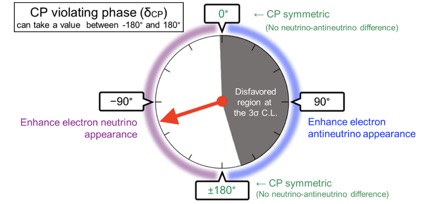Matter-antimatter difference found in neutrino oscillations
Published: 15 April 2020
A new research paper provides valuable new insight into how the symmetry between matter and antimatter is broken in neutrino oscillations.
One of the great scientific puzzles of our time is why we live in a universe full of matter rather than antimatter. Wherever we look, we observe that matter dominates over antimatter, yet we believe that matter and antimatter were created in equal amounts soon after the Big Bang. To reconcile these two facts there must be some difference in the way matter and antimatter behave.
Experiments using accelerators that create heavy particles containing quarks show some degree of difference with their antiparticle counterparts - an asymmetry known as Charge-Parity, or CP, violation.
However, despite knowing there is a difference between heavy particles and their antiparticles, the overall effect of these differences is too small to explain the imbalance between matter and antimatter that arose in the early universe.
Another alternative is that very light neutral particles, called neutrinos behave differently to their antimatter counterparts, antineutrinos. Neutrinos are particles without charge and with very small mass that interact very weakly with normal matter. They come in three types: electron, muon and tau neutrinos. They show a mysterious property, called neutrino oscillations, that allows them to transform from one type to another in flight, a discovery that was awarded the 2015 Nobel Prize in Physics.
A new research paper, published today in Nature and supported by researchers from the University of Glasgow, provides valuable new insight into how the symmetry between matter and antimatter is broken in neutrino oscillations.
The new paper is the outcome of research conducted by the T2K collaboration using facilities at the Japan Proton Accelerator Research Complex (J-PARC) facility in Tokai on the east coast of Japan. The T2K team’s accelerator creates beams of muon neutrinos and antineutrinos which then travel 295 km to the gigantic Super-Kamiokande detector, located in a tank filled with 50,000 tons of water under a mountain in Kamioka, on Japan’s west coast.
In this trip, the muon neutrinos and antineutrinos change in flight to electron neutrinos and antineutrinos, demonstrating the phenomenon of neutrino oscillations. The appearance of the electron neutrinos and antineutrinos was first established by T2K in 2011. What T2K has now observed for the first time is a significant difference between neutrino and antineutrino oscillations.
The weird world of quantum mechanics is responsible for neutrino oscillations. The parameter that governs the difference between matter and antimatter in neutrino oscillations is a relative phase between the neutrino and anti-neutrino states, called delta_CP.
This parameter can vary between -180° and +180°. When the parameter is 0° or ±180° there is no difference between neutrino and antineutrino oscillations, and scientists say that CP is symmetric. When the CP phase is greater than zero antineutrinos oscillate at a higher rate than neutrinos and this difference is maximal when is +90°. Conversely, when the CP phase is smaller than zero neutrinos change in flight more often than antineutrinos and, in both cases, scientists talk about CP violation.
In the results published today, the CP phase of 0° is disfavoured by the experiment at more than 3 standard deviations (3σ), corresponding to a probability of less than 0.3% that results are just an accidental fluctuation. In fact, nearly half of the parameter space for the CP phase is excluded at more than 3 standard deviations (see Figure 1).

Beams of predominantly muon neutrinos and antineutrinos are created at the J-PARC accelerator facility. Muon and electron neutrinos (and antineutrinos) are distinguished by the pattern of light in the Super-Kamiokande detector from the creation of electrons and muons in their collisions in the water. After 9 years of data taking, Super-Kamiokande observed 90 electron neutrinos and only 15 electron antineutrinos.
The expectation, assuming that the CP phase is -90°, is that Super-Kamiokande should have observed 82 electron neutrinos and 17 electron antineutrinos, while the expectation for the CP phase being +90° is for 56 electron neutrinos and 22 electron antineutrinos. The experiment clearly favours a value of smaller than zero, with an indication that the difference may be close to its maximum value of -90°.
While the experiment shows a clear preference for neutrino oscillation over antineutrino oscillation, it is not yet certain if the CP symmetry is violated or not. To improve these results, the T2K experiment is upgrading its experimental facilities and J-PARC will increase its beam intensity, in order to enhance the experimental sensitivity.
The University of Glasgow team has been a member of the collaboration since 2018 and has contributed to the construction of a brand new detector system, as part of the upgraded facilities at J-PARC.
Dr Phillip Litchfield, who leads the Glasgow neutrino oscillation effort, has been a member of T2K since 2007 and is a co-recipient of the 2016 Breakthrough Prize.
He said: “We have known for over 50 years that violation of CP symmetry might explain the existence of matter in the universe, but we haven’t been able to identify a mechanism that would work in practice. This result shows that neutrinos could be the key part of that mechanism.”
Professor Paul Soler added: "The key to understanding the difference between matter and antimatter is probably related to the properties of neutrino and antineutrino oscillations. This shows the first hints that CP violation in neutrino oscillations is right around the corner.”
Professor Lars Eklund said: "The discrepancy between the matter-antimatter asymmetry we observe in experiments at the microscopic scale and what we observe in the universe is one of the big open questions in physics, and this result indicate that neutrinos could provide a new mechanism that can generate this asymmetry."
Dr John Nugent, a postdoctoral research assistant, said: "This exciting result gives us a hint of the value of the CP phase, a crucial ingredient in understanding the difference between matter and antimatter in our universe.”
First published: 15 April 2020
<< April

